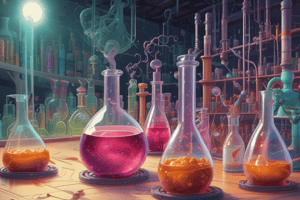Podcast
Questions and Answers
What is the primary purpose of a burette in volumetric analysis?
What is the primary purpose of a burette in volumetric analysis?
- Mixing two solutions thoroughly
- Cleaning other equipment with distilled water
- Measuring accurate volumes of solutions
- Pouring measured volumes of solutions (correct)
All primary standard substances must be hygroscopic.
All primary standard substances must be hygroscopic.
False (B)
What is the required equivalent weight of a standard solution when preparing it?
What is the required equivalent weight of a standard solution when preparing it?
An equivalent weight or a definite fraction or multiple of pure reagent
To neutralize 25.0 mL of 0.1 N sodium hydroxide, ______ mL of 0.2 N hydrochloric acid are required.
To neutralize 25.0 mL of 0.1 N sodium hydroxide, ______ mL of 0.2 N hydrochloric acid are required.
Match the following equipment with their purposes in volumetric analysis:
Match the following equipment with their purposes in volumetric analysis:
According to the Arrhenius theory, what characterizes an Arrhenius acid?
According to the Arrhenius theory, what characterizes an Arrhenius acid?
A Bronsted-Lowry base is defined as a proton donor.
A Bronsted-Lowry base is defined as a proton donor.
What happens when an acid donates a proton in terms of conjugate pairs?
What happens when an acid donates a proton in terms of conjugate pairs?
In the Lewis theory, a Lewis acid is defined as an __________-pair acceptor.
In the Lewis theory, a Lewis acid is defined as an __________-pair acceptor.
Match the following terms with their definitions:
Match the following terms with their definitions:
Flashcards
1.0 M NaCl solution
1.0 M NaCl solution
A solution containing 1 mole of NaCl (58.45 grams) dissolved in enough water to make a final volume of 1 liter.
Preparing a solution
Preparing a solution
Steps to create a solution with a specific concentration, typically involving weighing a solute, dissolving in a solvent, then bringing the volume to a specific mark.
Arrhenius Acid
Arrhenius Acid
A substance that increases the concentration of H+ ions when dissolved in water
Arrhenius Base
Arrhenius Base
Signup and view all the flashcards
Bronsted-Lowry Acid
Bronsted-Lowry Acid
Signup and view all the flashcards
Bronsted-Lowry Base
Bronsted-Lowry Base
Signup and view all the flashcards
Conjugate Acid-Base Pair
Conjugate Acid-Base Pair
Signup and view all the flashcards
Lewis Acid
Lewis Acid
Signup and view all the flashcards
Lewis Base
Lewis Base
Signup and view all the flashcards
Neutralization Reaction
Neutralization Reaction
Signup and view all the flashcards
Normality (N)
Normality (N)
Signup and view all the flashcards
Moles
Moles
Signup and view all the flashcards
Molarity (M)
Molarity (M)
Signup and view all the flashcards
Volumetric Analysis
Volumetric Analysis
Signup and view all the flashcards
Pipette
Pipette
Signup and view all the flashcards
Burette
Burette
Signup and view all the flashcards
Primary Standard
Primary Standard
Signup and view all the flashcards
Preparation of Standard Solutions
Preparation of Standard Solutions
Signup and view all the flashcards
Equivalence Point
Equivalence Point
Signup and view all the flashcards
Study Notes
Basics of Analytical Chemistry
- Course title: Basics of Analytical Chemistry
- Course codes: chm201, chm219B
- Instructor: Dr Ibrahem M A Hasan
Examples
- Example 1: Calculating volume of HCl needed to neutralize NaOH. 25.0 mL of 0.1 N sodium hydroxide requires 12.5 mL of 0.2 N HCl.
- Example 2: Determining strength of ferrous sulfate solution. A 25 mL solution of ferrous sulfate completely reacts with 30 mL of 0.125 M KMnO4. The solution's concentration is 22.78 g/L.
- Example 3: Calculating volume of reagent needed for dilution. Preparation of 1000 mL of 0.1 N solution from 0.127 N reagent requires 787.4 mL of the latter.
The Equipment
- Volumetric analysis uses specific equipment.
- Pipette: Precisely measures solution volumes.
- Burette: Delivers measured volumes of solutions.
- Conical flask: Mixing solutions.
- Wash bottle: Contains distilled water for cleaning.
- Funnel: Transferring liquids with minimal spillage.
- Volumetric flask: Preparing solutions of known concentration with specific volumes.
Requirements of primary standard substances
- Easy to obtain, purify, dry, and preserve: Preferably at 110-120°C.
- Stable in air: Should not be altered by air, humidity, or carbon dioxide.
- Testable for impurities: Should be capable of being tested for impurities.
- High equivalent weight: To minimize weighing errors.
- Soluble under conditions of use: Facilitates solution preparation.
- Examples: Sodium carbonate, borax, potassium hydrogen phthalate, and sodium chloride.
Preparation of standard solutions
- Weigh a precise amount of pure reagent.
- Dissolve it in the minimum volume of solvent (usually water).
- Transfer the solution to a volumetric flask.
- Fill the flask to the mark with solvent and mix thoroughly.
- 1.0 M NaCl solution example: Weigh 58.45 grams of NaCl and add it to 1.0 L volumetric flask, then dissolve with water to the mark.
Theory of acid-base titration
- 1. Arrhenius theory:
- Acid: Solution with excess H+ ions.
- Base: Solution with excess OH- ions. H+ + OH- → H₂O.
- 2. Brønsted-Lowry theory:
- Acid: Proton (H+) donor.
- Base: Proton (H+) acceptor. HCl(g) + H₂O(l) → H₃O+(aq) + Cl-(aq).
- 3. Lewis theory:
- Acid: Electron-pair acceptor.
- Base: Electron-pair donor.
Conjugate acid-base pairs
- Conjugate acid-base pairs differ by one proton.
- When an acid donates a proton, it forms the conjugate base.
- HCI(g) → Cl-(aq) (acid → conjugate base).
- When a base accepts a proton, it forms the conjugate acid. H₂O(l) → H₃O+(aq) (base → conjugate acid).
- Acid + Base → Conjugate base + Conjugate acid.
Relative Strengths of Conjugate Acid-Base Pairs
- List of acids and their conjugate bases, ordered by relative strengths.
Equivalent weight
- Acid: The weight containing one replaceable hydrogen (MW/basicity). -Monobasic acid have Equivalent weight and molecular weight same.
- Base: The weight containing one replaceable hydroxyl group (MW/acidity).
- Compound: Molecular weight/number of electrons charges.
- A normal solution of monobasic acid contains 1 MW per Liter.
- example calculations for dibasic and tribasic acids.
Hydrogen-ion concentration and the pH scale
- Self-ionization of water: H₂O + H₂O ↔ H₃O⁺ + OH⁻.
- Equilibrium constant (Kw): Kw = [H₃O⁺][OH⁻] = 1.0 x 10⁻¹⁴
pH and pOH
- pH: Negative logarithm of the hydronium ion concentration
- pOH: Negative logarithm of the hydroxide ion concentration.
- Relationships among hydrogen and hydroxide concentration and pH.
Examples (Calculations)
- Example 1: Calculate pH from given hydronium ion concentration.
- Example 2: Calculate hydronium ion concentration from pH.
- Example 3: Calculate pH of a given acetic acid solution (including dissociation).
Calculating [H⁺] or pH from ionization constants
- Henderson-Hasselbalch equation: For weak acids, pH = pKa + log([salt]/[acid]).
- Titration: Finding [H+] (e.g. in an acid-base titration.
Studying That Suits You
Use AI to generate personalized quizzes and flashcards to suit your learning preferences.




